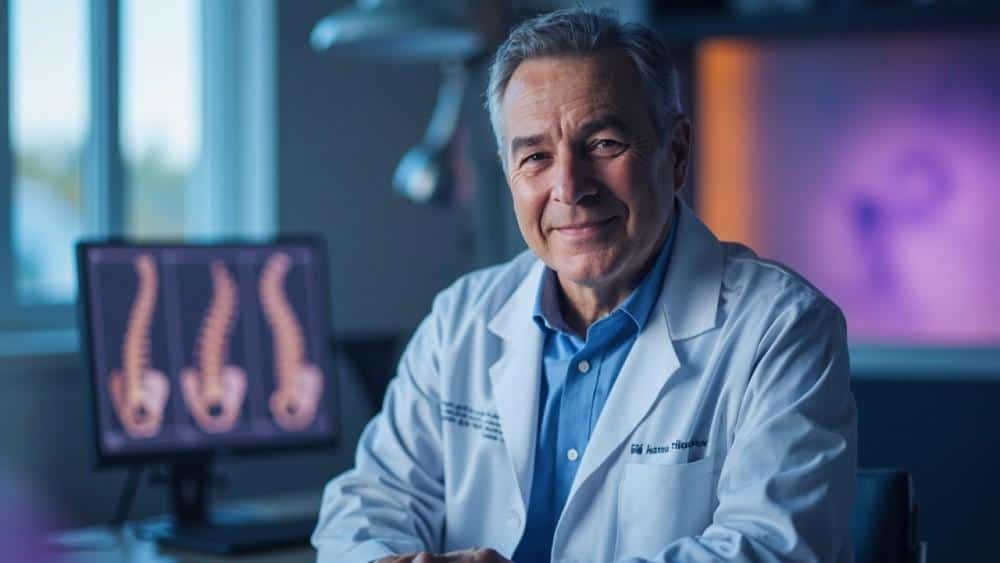What Is Cervical Spinal Fusion and Why You Should Consider Alternatives?
Written by Dr. Matthias Wiederholz, MD — Quadruple Board Certified Spine & Pain Specialist
Quick Insights
Cervical spinal fusion is a surgical procedure that joins two or more neck vertebrae together, eliminating motion. While it stabilizes the spine, it can significantly restrict movement and may lead to long-term health concerns, according to medical studies.
Key Takeaways
- The most common causes for cervical spinal fusion are severe disc degeneration, trauma, or persistent nerve pain unresponsive to less invasive treatments.
- Potential complications include difficulty swallowing, device failure, infection, or nerve injury during or after surgery.
- Studies note the risk of developing adjacent segment disease—added stress on nearby areas increases the chance of further spine problems.
- Active individuals may experience decreased neck mobility after cervical fusion, which can affect their work and lifestyle.
Why It Matters
Understanding cervical spinal fusion helps you make informed choices about your health, especially if you value staying active or worry about losing independence. Knowing the risks of neck fusion and limits of fusion empowers you to explore safer, less invasive options—helping you return to life pain-free and on your terms.
As a quadruple board-certified interventional pain and regenerative medicine specialist, I bring advanced expertise to cervical spinal fusion and its effects on active patients in Houston. For more about my experience, see my bio here.
Cervical spinal fusion is a surgical procedure that joins two or more vertebrae in the neck, eliminating motion between them. While this technique can stabilize the spine after trauma or degeneration, it also restricts neck mobility and may lead to additional stress on surrounding segments—a serious consideration for anyone who values an active lifestyle.
Having treated thousands struggling with neck pain, I’ve seen firsthand the anxiety and uncertainty these decisions create. Research demonstrates that recovery depends not just on a successful operation, but also on optimal postoperative care and specialized rehabilitation, highlighting the complexity of spine surgery outcomes.
If you’re wondering what is cervical spinal fusion—and whether there are safer, more active-friendly alternatives—this guide was created for you.
What Is Cervical Spinal Fusion?
Cervical spinal fusion is a surgical procedure that permanently joins two or more vertebrae in your neck, eliminating movement between them. This is typically performed to stabilize the spine after injury, severe disc degeneration, or persistent nerve pain that hasn’t responded to less invasive treatments.
During the operation, a surgeon removes the damaged disc and inserts bone graft material or a device between the vertebrae. Over time, the bone grows together, forming a solid bridge. While this can relieve certain types of pain, it also restricts neck mobility and may place extra stress on the remaining discs.
In my practice, I frequently encounter patients who have spent years exploring treatments—from surgeries to pain medications—without achieving meaningful relief. Often, they are unaware that minimally invasive regenerative solutions like Discseel® can effectively restore their spine health.
Patients may experience reduced neck mobility after cervical fusion, potentially making daily activities like driving or exercising more challenging. For active individuals, this loss of motion can be especially frustrating.
Research shows that cervical spinal fusion is associated with a range of neck fusion complications, including difficulty swallowing, hoarseness, hardware failure, infection, and even nerve injury as detailed in a review of ACDF complications[1]. These risks are not rare and can significantly impact quality of life, especially for those who value staying active.
It’s important to understand that while fusion can stabilize the spine, it does not restore the natural movement or function of the neck. Many patients are surprised to learn that the procedure may cause new problems over time, such as increased wear and tear on the discs above and below the fused segment according to comparative spine surgery studies[2]. Adjacent segment disease is a serious long-term concern.
For more about treating disc degeneration prior to surgery, review the comprehensive guide to L5-S1 bulging disc.

Risks and Complications of Cervical Spinal Fusion
Cervical spinal fusion carries several risks, both during and after surgery. The most common surgical risks include infection, bleeding, nerve injury, and adverse reactions to anesthesia. As a quadruple board-certified regenerative medicine specialist, I’ve observed that even with meticulous technique, these complications can occur and may require additional treatment or revision surgeries.
Quick-Scan: Major Cervical Fusion Risks
- Infection
- Difficulty swallowing (dysphagia)
- Hoarseness (nerve irritation)
- Hardware/device failure
- Nerve or blood vessel injury
- Reduced neck mobility
- Adjacent segment disease
These risks are not limited to the operating room—they can follow you for months or years, sometimes leading to further intervention. As a local Houston specialist, I’ve helped many patients who have experienced complications after spinal fusion elsewhere and are seeking better outcomes.
Common Surgical Risks
- Infection: Can develop at the incision site or deeper in the spine.
- Dysphagia (difficulty swallowing): Frequently reported after anterior approaches.
- Hoarseness: Often results when the nerves that move the vocal cords become irritated or damaged.
- Hardware failure: Screws or plates can loosen or break over time.
- Nerve or vascular injury: While rare, these can result in significant disability.
A comprehensive review of anterior cervical discectomy and fusion (ACDF) confirms these risks, citing dysphagia, hoarseness, hardware failure, infection, and neurovascular complications as significant postoperative concerns in published research[1].
If you’d like more detail on fusion risks, read our blog: What are the symptoms of bulging disc in neck C5-C6?
Long-Term Complications and Adjacent Segment Disease
Long-term, one of the most concerning problems is adjacent segment disease—where the discs and joints above or below the fusion site wear down more quickly due to increased mechanical stress. This can lead to new pain, nerve symptoms, or even the need for additional surgeries. Studies show the readmission rate after posterior cervical fusion has actually increased over the past decade—from 6.4% in 2012 to 6.7% in 2022—highlighting the persistence of long-term issues per recent outcome analyses[3].
Moreover, some patients may require additional interventions after cervical fusion, potentially leading to increased healthcare costs and emotional stress.in long-term studies[4].
Find more about fusion failure symptoms in our latest resource.
Signs and Symptoms of Fusion Failure
Fusion failure may cause persistent neck pain and instability, and in some cases, hardware-related issues. Hardware problems may cause a grinding sensation or physical shifting in the neck. If you notice these symptoms, it’s critical to seek prompt evaluation from an experienced spine specialist.
Notably, research identifies several predictors of better outcomes after fusion[5]: shorter preoperative pain duration, lower disability index scores, and being a nonsmoker are associated with more positive results one year after surgery. However, patients undergoing cervical fusion may face complications or experience less improvement than anticipated following surgery.
For a primer on treatment failures, see herniated disc symptoms, causes, and treatment.
When to Seek Medical Attention
If you experience sudden weakness, loss of bladder or bowel control, or severe neck pain after surgery, contact your physician immediately. These may be signs of a serious complication requiring urgent care.
Having personally performed over 10,000 regenerative spine procedures, I’ve consistently witnessed that truly restoring function and alleviating chronic pain involves not just clinical excellence, but a deep emotional and functional understanding of each patient’s needs.

Why Do Patients Seek Alternatives to Neck Fusion Surgery?
Many patients come to me searching for alternatives to neck fusion because they’re understandably concerned about risks like reduced mobility, a long and complicated recovery period, and the potential for new or ongoing spine problems.
Unlike larger clinics where patients may rarely see the same provider, I personally oversee every aspect of each patient’s care—from diagnostics to procedure, recovery, and rehabilitation—so you feel heard, supported, and truly understood.
Consider also reading: Disc desiccation: understanding the causes, symptoms, and treatment.
Impact on Lifestyle and Mobility
Cervical spinal fusion can limit your ability to turn, tilt, or extend your neck, making simple activities like driving, playing sports, or sleeping comfortably much more difficult. I’ve watched active Houstonians—including “Active Alex,” a typical patient profile—struggle to return to hiking, golfing, or their favorite gym classes after fusion.
Both research and personal observation confirm that while surgical and nonsurgical treatments for cervical radiculopathy (pinched nerve in the neck) aim to improve function, recovery timelines after cervical spinal fusion surgery may vary and are not always faster or more complete compared to non-surgical treatments. according to two recent large clinical trials[6]. In fact, rehabilitation is universally acknowledged as essential for recovery, yet recovery approaches following cervical spinal fusion vary, and optimal strategies may differ among healthcare providers. per systematic reviews of postoperative rehab[7].
If adjacent segment disease is a concern, see our guide to spinal disc tears.
Patient Stories: Fear, Recovery, and Hope
In my Houston and New Jersey practices, I often meet patients who are frustrated and anxious about fusion surgery’s long-term effects. They’ve seen friends or relatives lose quality of life or undergo multiple additional procedures. These concerns are real, and I believe every patient deserves to understand all options so they can make the best choice for their life and goals.

Introducing the Discseel® Procedure: A Regenerative Solution
The Discseel® Procedure is a minimally invasive, non-surgical alternative to cervical spinal fusion. By using a biologic fibrin sealant, I repair damaged spinal discs and stimulate natural collagen regeneration—addressing the root cause of pain rather than simply restricting spinal motion. As one of only a handful of certified Master Instructors for the Discseel® Procedure, trained by Dr. Kevin Pauza himself, I’m proud to offer this advanced therapy in Houston and New Jersey. Learn more at the Discseel® official website[8].
How Discseel® Works
Discseel® targets the annulus fibrosis (the tough, outer ring of a spinal disc) and seals tears that trigger inflammation, instability, and pain. The fibrin sealant acts as a biological patch, allowing natural healing and disc function restoration. I perform this procedure in-office, under local anesthesia, with no hardware or incisions—most patients are back to their daily activities in days, not weeks or months.
If you want more information about alternatives, check out Discseel reviews: achieving lasting back pain relief.
As a board-certified spine specialist leading over 10,000 minimally invasive procedures, I’ve seen firsthand that restoring spine health is not just a medical task but a partnership—helping each patient reclaim movement, confidence, and quality of life on their own terms.
Unlike fusion, Discseel® preserves cervical mobility and dramatically reduces the risk of adjacent segment disease, hardware problems, or lifelong motion loss.
Success Rates: Discseel® vs Cervical Fusion
Discseel® is an emerging procedure aimed at relieving pain and restoring function; however, its comparative success rates with spinal fusion are not yet well-established.
To put this in perspective:
| Discseel® Procedure | Cervical Spinal Fusion | |
|---|---|---|
| Surgical incision | No | Yes |
| General anesthesia | No | Yes |
| Preserved neck motion | Yes | No |
| Hardware/risk of failure | None | Yes |
| Hospital stay | None (outpatient) | Yes (inpatient) |
| Adjacent segment disease | Rare | Common |
| Return to activity | Days | Weeks–Months |
| Long-term success rate | 31% |
Comparative research confirms that both surgical and nonsurgical approaches can produce improvements, but non-surgical options like Discseel® also preserve spinal motion and reduce future complications as outlined in randomized clinical trials[6].
Here’s what an independent review found: “Moving away from surgical fusion when possible can decrease medical complications, rehabilitation time, and total healthcare costs, while offering comparable—if not superior—functional results for many patients.” (source)[2].
For greater context on spinal healing, see our disc tear treatment guide.

Meet Dr. Matthias Wiederholz — Houston’s Regenerative Spine Expert
As a quadruple board-certified specialist and certified Master Instructor for the Discseel® Procedure, I am dedicated to providing advanced, minimally invasive spine care in Houston and New Jersey. My approach combines technical excellence with genuine compassion, focusing on restoring your spine so you can reclaim your life.
At Performance Pain & Sports Medicine, I offer cutting-edge regenerative treatments—including Discseel®, Superion® Interspinous Spacer, and spinal cord stimulation—right here in my practice. My goal is to help you get back to enjoying your everyday activities, without the risks and downtime of invasive surgery. To learn more about regenerative options, see our treatments for disc desiccation.
Frequently Asked Questions about Neck Fusion and Discseel®
What are the most common complications of cervical spinal fusion?
The most common risks include infection, difficulty swallowing (dysphagia), hoarseness, hardware failure, nerve or blood vessel injury, and adjacent segment disease (review of ACDF complications[1]). Each can significantly affect long-term recovery and function.
How long does it take to recover from cervical spinal fusion?
Most patients require several weeks to several months for bone healing and rehabilitation. However, neck motion may be permanently reduced, and adjunct rehabilitation is crucial for the best outcome (rehabilitation studies[9]). There is no single agreed-upon rehab protocol; recovery time varies greatly.
If you want to maximize recovery, read about herniated disc exercises.
Is cervical fusion the only option for severe neck pain?
No. Alternatives such as Discseel®, cervical disc replacement, and advanced regenerative therapies are increasingly effective for eligible patients (research on fusion alternatives[2]). A thorough evaluation is necessary to determine what’s best for your situation. Also, explore everything you need to know about new treatments for ruptured discs.
What predicts a good outcome from fusion surgery?
Patients with shorter pre-surgery pain duration, lower disability scores, and nonsmoking habits have better odds for a positive 12-month result (predictive factors research[5]), though risks remain for all individuals.
For more on degenerative spine conditions, see managing lumbar degenerative disc disease.
Why do active people avoid cervical fusion?
Loss of neck mobility, longer recovery, and risk of future adjacent segment problems make fusion unattractive for athletes, fitness fans, and anyone who values mobility (rehab/outcome reviews[7]).
You can also review emergency symptoms of a herniated disc.
How does Discseel® compare to fusion, and is there published research?
Discseel® preserves mobility and avoids hardware—a major benefit. While evidence supports non-surgical approaches for certain spinal conditions (RCT on non-surgical outcomes[6]), Discseel® is a newer therapy, supported by clinical success and growing adoption among regenerative specialists.
Ready to reclaim your active Houston lifestyle and avoid unnecessary fusion?
See if you are a candidate for the Discseel® Procedure—start your assessment here.
References available upon request and throughout the article for all medical statistics and research findings.

What Our Patients Say on Google
Patient experiences are at the heart of everything I do as a spine specialist. Hearing directly from those who have undergone advanced procedures like Discseel® provides valuable insight into the real-world impact of our approach.
I recently received feedback that captures what we aim to provide for every patient—hope, clarity, and meaningful improvement. This reviewer shared:
Houston Patient Review:
“I can’t say enough good things about Dr. Wiederholz. Previous pain specialists had dismissed the lower back pain I have had for more than three years as age related and, therefore, not likely to improve significantly. Dr. Wiederholz, however, provided me with hope for healing by performing the Discseel procedure on my lumbar spine. It has been almost a month and, although major regeneration of the disc collagen is not expected for 3-6 months, I am feeling better already — walking, getting in and out of cars and out of bed, etc. with less pain. My thanks to Dr. Wiederholz and his entire team for their care.”
— Read more Google reviews here
Stories like this remind me why it’s so important to offer alternatives to cervical spinal fusion—restoring hope and function for patients who have been told there are no other options.
Cervical Spinal Fusion and Regenerative Alternatives in Houston, TX
Houston is a city known for its active lifestyle, diverse population, and world-class medical community. Many of my patients here are dedicated to staying mobile—whether that means playing tennis at Memorial Park, cycling along Buffalo Bayou, or simply keeping up with family.
The unique demands of Houston’s climate and culture mean that neck pain and spinal conditions can have a significant impact on daily life. As a local physician, I understand how important it is for Houstonians to regain function quickly and avoid long-term limitations from procedures like cervical spinal fusion.
At Performance Pain and Sports Medicine, I’m proud to offer advanced, minimally invasive options—including the Discseel® Procedure—right here in Houston. My goal is to help you return to your favorite activities without the risks and downtime of traditional surgery.
If you’re in Houston and considering cervical disc fusion or want to explore regenerative alternatives, I invite you to schedule a consultation. Let’s work together to find the safest, most effective path back to the life you love.
Conclusion
To summarize, cervical spinal fusion can stabilize the spine but often leads to reduced neck mobility, long-term complications, and a significant impact on your quality of life—especially for active individuals in Houston. My experience as a quadruple board-certified regenerative specialist has shown that advanced alternatives like the Discseel® Procedure offer a safer, more effective path to pain relief and restored function. Research supports that non-surgical options can preserve motion and reduce future complications[2], helping you return to the activities you love.
If you’re tired of missing out on family events or daily routines because of chronic neck pain, I invite you to take the next step. Schedule a prompt appointment here—often available within 1–2 weeks—by calling (346) 217-1111 (Houston) or (609) 588-8600 (Lawrenceville). As a nationally recognized, quadruple board-certified regenerative specialist, I believe early intervention leads to better outcomes and helps you avoid unnecessary surgery. Let’s help you reclaim your life. Advanced regenerative care, without invasive surgery.
This article is for educational purposes only and should not be used as a substitute for professional medical advice, diagnosis, or treatment. Always seek the advice of your physician or other qualified healthcare provider with any questions you may have regarding a medical condition or treatment options. Never disregard professional medical advice or delay in seeking it because of something you have read in this article.
Frequently Asked Questions
What is cervical spinal fusion, and why might I want to avoid it?
Cervical spinal fusion is a surgery that permanently joins neck vertebrae, eliminating motion to stabilize the spine. Many patients want to avoid it because it can cause loss of neck mobility, increased risk of future spine problems, and a longer recovery. Non-surgical options like Discseel® can relieve pain while preserving movement and reducing complications.
Where can I find advanced alternatives to cervical spinal fusion in Houston?
You can find advanced, minimally invasive alternatives—including the Discseel® Procedure—at my Houston practice, Performance Pain and Sports Medicine. I offer prompt appointments and personalized care to help you return to your favorite activities without the risks of traditional surgery. Most patients are seen within 1–2 weeks.
As an active person, how do I know if I’m a good candidate for regenerative spine care?
If you value mobility and want to avoid the long-term limitations of fusion, you may be an excellent candidate for regenerative treatments. I assess your spine health, activity goals, and previous treatments to recommend the safest, most effective option. Many active patients experience faster recovery and better function with these advanced therapies.

















